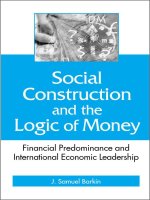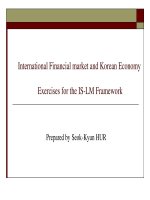Assignment 1 of international financial market and korean economy solution
Bạn đang xem bản rút gọn của tài liệu. Xem và tải ngay bản đầy đủ của tài liệu tại đây (143.46 KB, 2 trang )
IFM&KE
CAU MBA
Fall 2015
Answers to Problem Set 1
(Due on September 22nd, 2014)
1.
Suppose the United States economy is represented by the following equations:
Z=C+I+G
C = 500 + .5YD
YD = Y - T
G = 2000
T = 600
I = 300
(1) Given the above variables, calculate the equilibrium level of output.
At an equilibrium, Y = Z should be satisfied.
Z = C + I + G = 500 + 0.5YD + 300 + 2000 = 0.5(Y − T) + 2800 = 0.5(Y − 600) + 2800
Y = 0.5(Y − 600) + 2800
Solving the above equation with respect to Y, You will get the equilibrium output.
Y∗ = 5,000
(2) Now, assume that G is halved from 2000 to 1000. What is the new equilibrium level of output? How
much does income change as a result of this event? What is the multiplier for this economy?
Marginal Propensity to Consume(MPC) is 0.5 in the economy. It means $1 increase in G will lead to $2=1/(1-0.5)
increase in the aggregate output. So, the fiscal multiplier is 2.
In response to $1,000 reduction of G, the equilibrium output will be lowered by $2,000=$1,000*fiscal multiplier.
Accordingly, the new equilibrium output will be $3,000
(3) Briefly explain why this reduction in output is greater than (in absolute terms) the initial reduction in G.
In an economy one’s decision has interactions with others’. For example, one’s demand increase in the good
market leads to income increase of others. Also one, who just experienced income increase, tend to increase his
demand. All these interactions are summed and represented by the “fiscal multiplier”, the snow balling effect of
which is confirmed by its magnitude greater than 1.
(4) Explain what effect a reduction in the marginal propensity to consume has on the size of the multiplier.
Also, discuss the paradox of saving in the same context.
Reduction in the marginal propensity to consume means peoples tend to save more. The saved portions of income
will not contribute to increasing others’ income and the chained reactions described in (3) will become smaller.
As a results, the equilibrium output will be lowered. This is so called “the Paradox of Saving”.
However, the paradox is not always valid. For example, in reality saving will help the accumulation of capital,
which will later raise the productivity and the GDP of the economy. Such a feature is not included in the current
version of the IS-LM setup. In this context, the IS-LM framework is used only for analyzing the short-run business
fluctuations.
2.
First, explain why the money demand curve is downward sloping with respect to the interest rate.
Second,
explain what other factor(s) will cause shifts in the money demand curve.
An interest rate is an opportunity cost of holding money instead of bond. Hence, it is negatively related to the
demand quantity of money.
Nominal income (Real Income * the price level) will the other factor that influences money demand. Interest rate
1
IFM&KE
CAU MBA
Fall 2015
is a variable that people watch when they hold money as an asset. In contrast, nominal income reflects their money
demand for transactions.
3.
Explain what types of policies a central bank can implement to reduce the interest rate.
The central bank can buy bond with the newly printed money. Then, die to a surge in the bond price, the interest
rate will be lowered. This is an illustration of so called “an open market operation”.
4.
Graphically illustrate and explain what effect an increase in real income will have on the money market.
Money demand function will shift rightward. Accordingly, the equilibrium interest rate will be raised.
5.
Graphically illustrate and explain what effect a purchase of bonds by the Federal Reserve will have on the
money market.
The purchase of bonds by the Federal Reserve means money supply is increased. Accordingly, the equilibrium
interest rate will be lowered (see an answer to 3).
6.
Explain in detail what effect a sale of bonds by the central bank will have on: (1) the LM curve; and (2) the
IS curve.
The sale of bonds by the Federal Reserve means money supply is reduced. Accordingly, the equilibrium interest
rate will be raised at the same level of real GDP (Y). In other words, the LM curve will shift leftward. Though,
nothing changes in the IS curve, the new meeting point of the IS and the IM curves indicates the lower equilibrium
output and the higher equilibrium interest rate.
7.
Explain in detail what effect a reduction in government spending will have on: (1) the LM curve; and (2)
the IS curve.
The LM curve stays the same but IS curve will shift leftward. Hence, both the equilibrium output and the interest
rate are lowered.
8.
Based on your understanding of the IS-LM model, graphically illustrate and explain what effect a reduction
in consumer confidence will have on output, the interest rate, and investment.
A reduction in consumer confidence may lower the consumption demand and the demand for investment. So, it
means that the IS curve will shift leftward. Thus, both the equilibrium output and the interest rate are lowered.
9.
Use the IS-LM model to answer this question. Suppose there is a simultaneous increase in government
spending and reduction in the money supply. Explain what effect this particular policy mix will have on
output and the interest rate. Based on your analysis, do we know with certainty what effect this policy mix
will have on investment?
Explain.
The IS curve shifts rightward whereas the LM shifts leftward. Depending on which moves further, their combined
effect on the aggregate output will differ. On the other hand, they will raise the interest rate unanimously.
2









